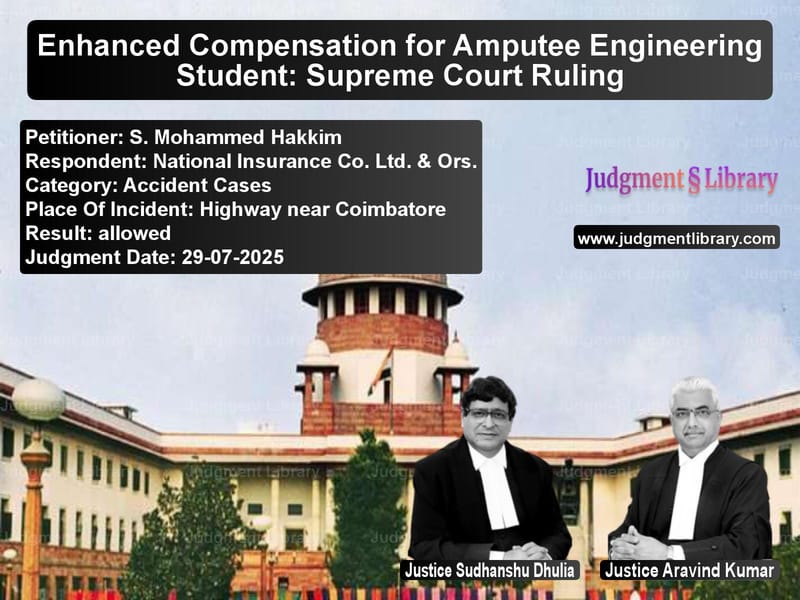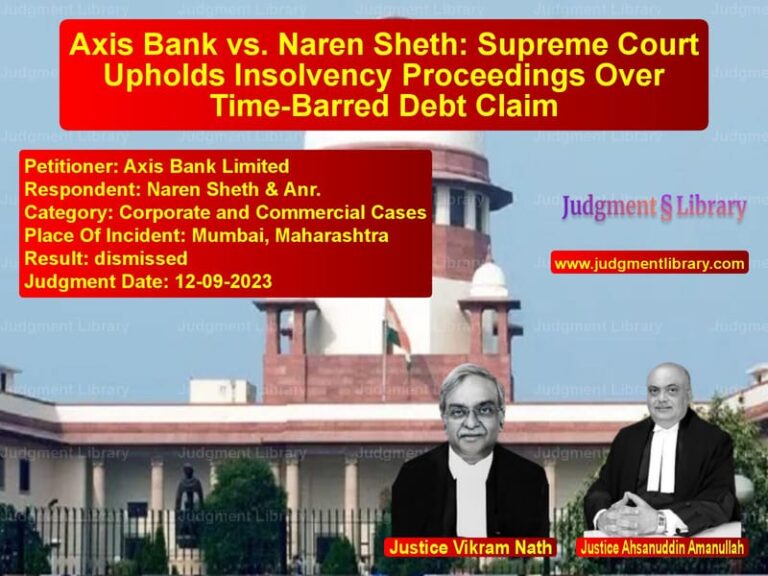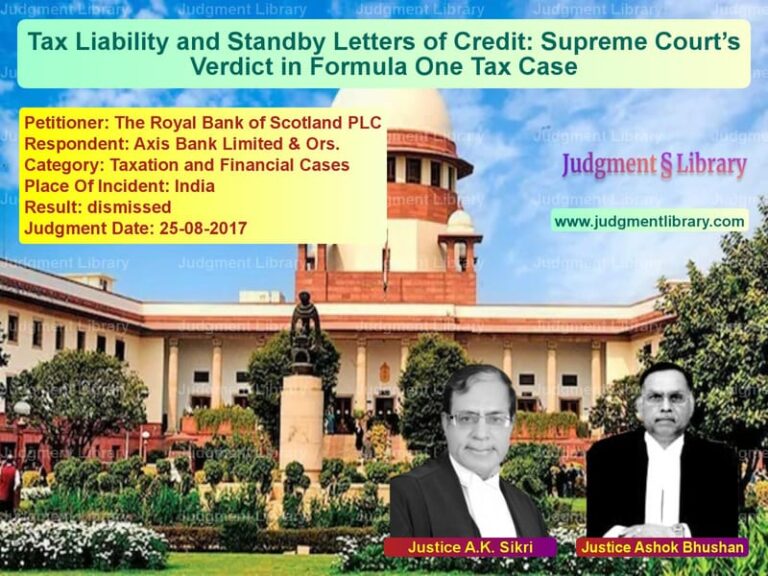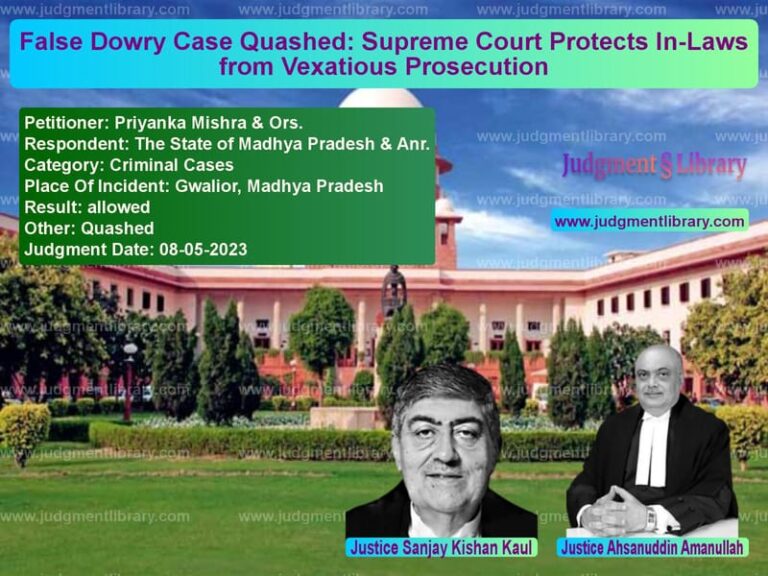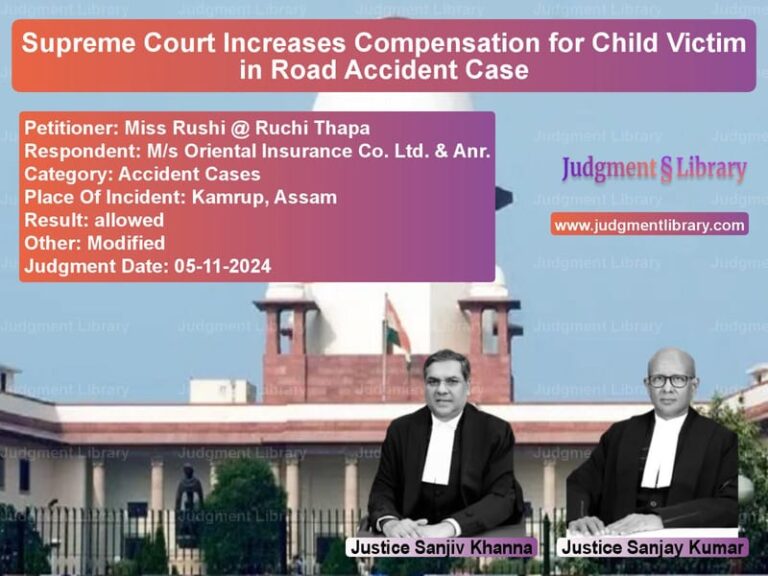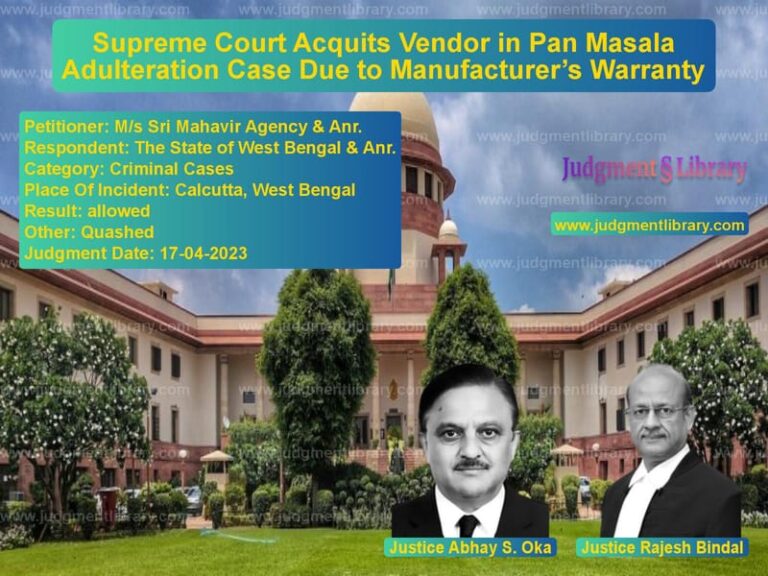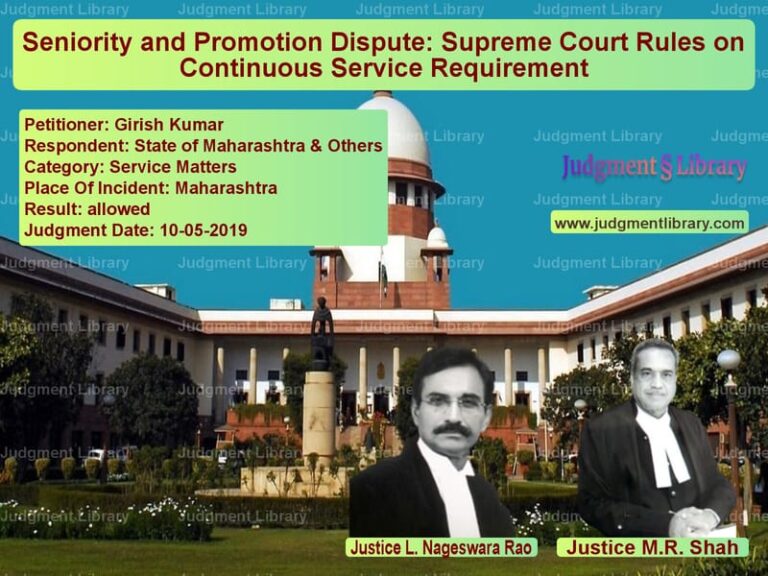Enhanced Compensation for Amputee Engineering Student: Supreme Court Ruling
In a landmark judgment that brings significant relief to victims of severe motor accidents, the Supreme Court has substantially enhanced the compensation awarded to a young engineering student who lost his leg in a tragic road accident. The case involves S. Mohammed Hakkim, who was just 20 years old and studying in his third year of engineering when a devastating accident changed his life forever, leading to the amputation of his left leg.
The unfortunate incident occurred on January 7, 2017, when Hakkim was riding a motorcycle with his friend as a pillion rider. A car ahead of them suddenly applied brakes, causing Hakkim to dash into the rear of the car and fall on the right side of the road. As fate would have it, a bus coming from behind ran over him, resulting in injuries so severe that his left leg had to be amputated during treatment. The legal battle that followed involved complex questions about negligence, compensation calculation, and the future prospects of a young student whose life had been permanently altered.
The case traveled through multiple judicial forums, with the Motor Accident Claims Tribunal initially awarding compensation of Rs. 91,62,066, which was reduced to Rs. 73,29,653 after accounting for 20% contributory negligence on Hakkim’s part. The Madras High Court further reduced this amount to Rs. 58,53,447, leading to the appeal before the Supreme Court.
The Court’s Analysis on Negligence
The Supreme Court carefully examined the question of contributory negligence and the responsibility of each party involved in the accident. The Court noted that the Tribunal, as well as the High Court, have affirmed that the accident occurred due to the sudden stoppage of the car. However, it was the view of the Tribunal that if the bus had not been involved in the accident, the appellant would have suffered normal injuries, and it was mainly the negligence of the bus driver that led to the amputation of the appellant’s leg.
The car driver had admitted in his evidence that he had suddenly applied the brakes as his wife was pregnant and she had a vomiting sensation. However, the Supreme Court found this explanation inadequate, stating: The explanation given by the car driver for suddenly stopping his car in the middle of a highway is not a reasonable explanation from any angle. On a highway, high speed of vehicles is expected and if a driver intends to stop his vehicle, he has a responsibility to give a warning or signal to other vehicles moving behind on the road. In the present case, there is nothing on record to suggest that the car driver had taken any such precaution.
After thorough consideration, the Court determined: we are of the view that the appellant is liable for contributory negligence but only to the extent of 20% whereas the car driver and bus driver are liable for negligence to the extent of 50% and 30% respectively.
Quantum of Compensation: Key Enhancements
The most significant aspect of the Supreme Court’s judgment was its comprehensive reassessment of the compensation amount, particularly focusing on the future prospects of the young engineering student.
The Court emphasized the importance of properly evaluating the notional income of a student with bright future prospects: In the present case, at the time of the accident, the appellant was a 3rd year engineering student who could have had a bright future. While dealing with a case of an accident in which an engineering student had lost one leg, this Court in Navjot Singh v. Harpreet Singh, 2020 SCC OnLine SC 1562 had noted that: Admittedly, the appellant was 21 years of age at the time of the accident and he was pursuing a Degree course in Food Technology from Sant Longowal Institute of Engineering and Technology. Though the Tribunal did not believe the claim made by the appellant that he was earning Rs. 10,000/- per month even as a student by taking tuitions, and though the High Court also did not go by the said claim, the High Court arrived at the notional income of the appellant at Rs. 5,000/- per month, on the ground that the minimum wages admissible to an unskilled worker was Rs. 5,000/- per month. But we do not think that the notional income of a student undergoing a Degree course in Engineering from a premier institute should be taken to be equivalent to the minimum wages admissible to an unskilled worker. Students recruited through campus interviews are atleast offered a sum of Rs. 20,000/- per month.
Based on this precedent and considering the current economic scenario, the Supreme Court enhanced the notional income from Rs. 15,000 to Rs. 20,000 per month, stating: Thus, in our opinion, it would be in the interest of justice if the notional income of the appellant were taken as Rs. 20,000/-.
Critical Analysis of Attendant Charges
One of the most important aspects where the Supreme Court differed from the High Court was regarding attendant charges. The Tribunal had awarded Rs. 18 lakhs for attendant charges, which the High Court reduced to Rs. 5 lakhs without providing substantial reasoning.
The Supreme Court strongly criticized this reduction: The High Court has rightly granted Rs.5,00,000/- for the future medical expenses but erred in reducing the attendant charges from Rs. 18 lacs to Rs. 5 lacs. In the present case, by taking charges of an attendant as Rs.6,000/- per month for 25 years, the Tribunal calculated the attendant charges as Rs. 18 lacs. While reducing it to Rs.5 lacs, the High Court has not given any cogent reasons and merely noted that fixing Rs.18 lacs as attendant charges is exorbitant and unreasonable. We are unable to understand how the attendant charges of Rs.18 lacs fixed by the Tribunal are unreasonable. The appellant has lost his entire left leg, which was amputated from waist downwards, which means that he would require assistance throughout his life to perform the basic daily routine. Thus, we hold that the attendant charges as fixed by the Tribunal were justified.
Enhanced Compensation for Loss of Marital Prospects
The Court also addressed the sensitive issue of loss of marital prospects, which is particularly relevant for a young person facing permanent disability. The Tribunal had granted Rs. 2.5 lakhs under this head, which the High Court had affirmed. However, the Supreme Court found this amount insufficient: However, in our view, it is not sufficient, and in the interest of justice, it shall be increased to Rs. 5 lacs.
Final Compensation Calculation
The Supreme Court meticulously calculated the final compensation under various heads:
Loss of Income: Rs. 60,48,000/- (based on monthly income of Rs. 20,000 with 40% future prospects and multiplier of 18)
Attendant Charges: Rs. 18,00,000/- (restored from High Court’s reduction)
Pain & Sufferings: Rs. 2,00,000/-
Loss of Marital Prospects: Rs. 5,00,000/- (enhanced from Rs. 2.5 lakhs)
Discomfort: Rs. 1,00,000/-
Extra Nourishment: Rs. 50,000/-
Medical Bills: Rs. 22,03,066/-
Transportation: Rs. 20,000/-
Damage to Clothing: Rs. 3,000/-
Future Medical Expenses: Rs. 5,00,000/-
The total compensation calculated was Rs. 1,14,24,066. After deducting 20% for contributory negligence, the final amount payable to Hakkim was Rs. 91,39,253 along with interest at 7.5% per annum from the date of filing the claim petition.
The Supreme Court directed that the compensation should be paid within four weeks, with the car insurer bearing 50% of the liability and the bus insurer 30%, corresponding to their determined negligence percentages.
This judgment sets an important precedent for how courts should assess compensation in cases involving young students with promising futures. It recognizes that the loss suffered by such individuals extends far beyond immediate medical expenses and includes the destruction of their career prospects, personal life, and overall quality of life. The Court’s sensitive handling of aspects like attendant charges and loss of marital prospects demonstrates a holistic understanding of the multifaceted impact of severe disabilities on a person’s life.
The ruling reinforces the principle that compensation in motor accident cases should not merely cover immediate losses but should adequately provide for the long-term consequences of permanent disabilities, ensuring that victims can maintain a dignified quality of life despite their disabilities.
Petitioner Name: S. Mohammed Hakkim.Respondent Name: National Insurance Co. Ltd. & Ors..Judgment By: Justice Sudhanshu Dhulia, Justice Aravind Kumar.Place Of Incident: Highway near Coimbatore.Judgment Date: 29-07-2025.Result: allowed.
Don’t miss out on the full details! Download the complete judgment in PDF format below and gain valuable insights instantly!
Download Judgment: s.-mohammed-hakkim-vs-national-insurance-c-supreme-court-of-india-judgment-dated-29-07-2025.pdf
Directly Download Judgment: Directly download this Judgment
See all petitions in Road Accident Cases
See all petitions in Compensation Disputes
See all petitions in Motor Vehicle Act
See all petitions in Negligence Claims
See all petitions in Insurance Settlements
See all petitions in Judgment by Sudhanshu Dhulia
See all petitions in Judgment by Aravind Kumar
See all petitions in allowed
See all petitions in supreme court of India judgments July 2025
See all petitions in 2025 judgments
See all posts in Accident Cases Category
See all allowed petitions in Accident Cases Category
See all Dismissed petitions in Accident Cases Category
See all partially allowed petitions in Accident Cases Category

